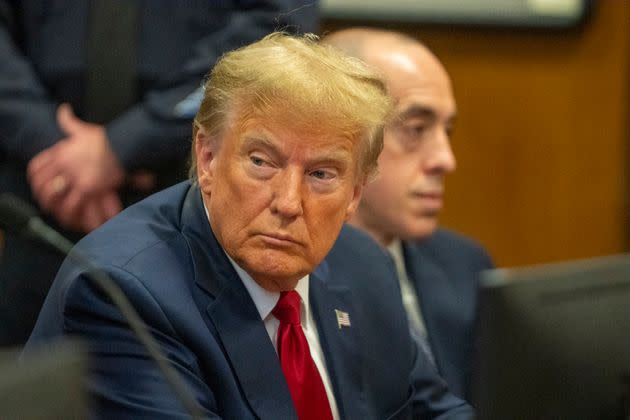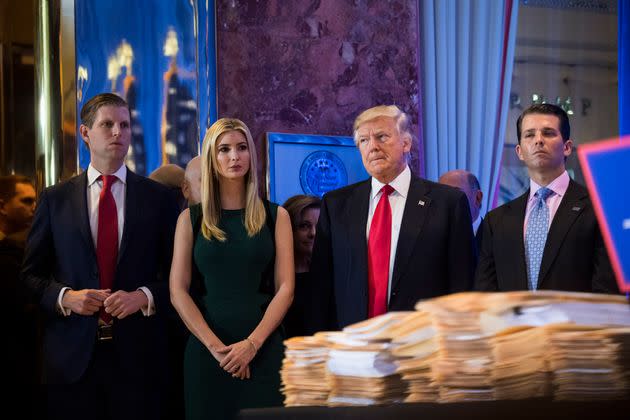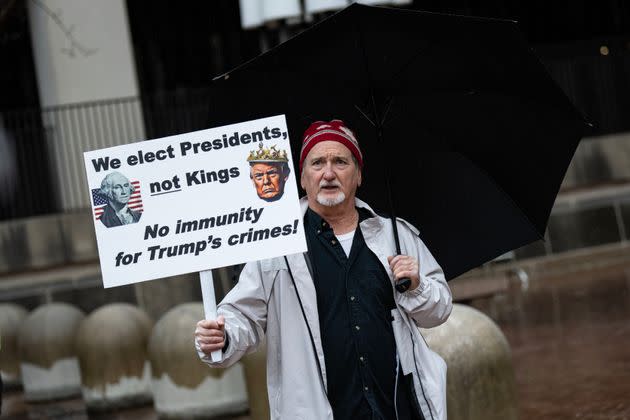The Courts Let Trump Run Out The Clock When He Was President. They’re Doing It Again.
- Oops!Something went wrong.Please try again later.
- Oops!Something went wrong.Please try again later.
- Oops!Something went wrong.Please try again later.
Former president and current GOP presidential front-runner Donald Trump’s top priority since being indicted in four different jurisdictions on dozens of felony charges has been clear: Delay the trials until after the election.
The Supreme Court gave Trump exactly what he wanted when it agreed to hear arguments on April 25 regarding Trump’s claim that he has an “absolute immunity” from federal prosecution for attempting to overturn his 2020 election loss.
By taking the case and scheduling a hearing on April 25, the court has radically increased the chances that the trial will not reach a verdict prior to the Nov. 5 general election. It wouldn’t be the first time the Supreme Court, like other federal courts, has helped Trump dodge the consequences of litigation by running out the clock.
During Trump’s presidency, the courts extended consideration of the disclosure of Trump’s financial records and his profiteering off of foreign and domestic governments for so long, neither case was resolved until after he’d left office.
Whether it was a direct Supreme Court decision or simply the fact that the judicial system can be exploited by those with means to create strategic delays, the courts have made sure that time is always on Trump’s side.
Trump’s financial documents
After Democrats won control of the House of Representatives in 2018, they launched investigations into Trump’s financial interests, from which he had refused to divest after he was elected. These investigations led three House committees to subpoena two banks, Deutsche Bank and Capital One, and one accounting firm, Mazars, for Trump’s financial records in April 2019. The committees claimed they needed the records to investigate corruption and financial fraud as they pursued various pieces of potential legislation.

Trump sued the three companies to prevent them from handing over documents. Those cases wound their way through the federal court system until they reached the Supreme Court as a consolidated case. The court issued a 7-2 decision on July 9, 2020, rejecting Trump’s argument that the committees could not subpoena the documents ― but it ordered the issue back to lower courts to determine what reasoning congressional committees could use to subpoena such documents without running into problems involving separation of powers.
While the decision was a loss for Trump on the main question, it was a technical win by delaying the disclosure of his financial documents until after the 2020 election and until after he left office. And, had Democrats also lost control of the House in 2020, the entire case would have been over, as Republicans almost certainly would not have refiled the subpoenas needed to obtain the documents.
But Democrats retained control of the House and, while their original subpoenas expired at the end of the previous Congress, the oversight committee refiled the subpoenas on Feb. 23, 2021. Trump again sued to block the committee, and 18 months later, the D.C. Circuit Court of Appeals rejected his argument. In August 2022, Trump and the committee reached an agreement limiting the documents that Mazars would provide. The committee received its first tranche of documents in September 2022.
From beginning to end, the attempt by Congress to obtain Trump’s financial documents took three years and five months to work its way through the courts. By the time it was done, Trump was out of office, and Democrats were a little more than three months away from losing control of the committee set to receive the documents. When Republicans took over the committee in January 2023, they stopped asking Mazars for the material.
It took even longer for the courts to finish hearing the legal challenge to Trump’s profiteering from foreign and domestic governments. And those cases ended with no resolution.
The emoluments clause
When Trump took office, he refused to divest from his business empire, despite making a show of doing so. He instead put it into a trust and placed his sons Donald Jr. and Eric in charge.
This posed an issue with the Constitution’s emoluments clause, which forbids U.S. government officials from benefiting from gifts, payments or anything of value provided by foreign or domestic governments. And his properties ― including his resorts, golf courses, office buildings and, especially, his hotel just blocks from the White House ― presented opportunities for governments to put money directly in his pocket.

Foreign and domestic governments did just that. The governments of China, Saudi Arabia, the Philippines and Qatar, among others, funneled millions of dollars into Trump’s pockets through his properties. Similarly, Paul LePage, at the time the GOP governor of Maine, had the state government pay for 40 rooms at Trump’s D.C. hotel.
Lawsuits challenging Trump’s receipt of these emoluments ― gifts, payments or things of value ― were launched early in his presidency. The liberal legal group Citizens for Responsibility and Ethics in Washington, later joined by a group of restaurants and hotels, sued Trump on Jan. 23, 2017. The attorneys general of Maryland and Washington, D.C., filed a separate suit on June 12, 2017. And a group of Democratic members of Congress, led by Sen. Richard Blumenthal (Conn.), filed their own lawsuit two days later.
Trump challenged all of the suits on the same grounds: that none of the plaintiffs had standing to sue and, therefore, they should all be dismissed. All three suits spent years going back and forth between federal district courts and appeals courts as judges couldn’t agree on whether the plaintiffs could bring the suits in the first place.
Finally, in September 2019, a panel for the 2nd Circuit Court of Appeals declared that plaintiffs in the CREW case had standing to sue. The congressional case was ultimately dismissed in December 2019. Meanwhile, the case from the D.C. and Maryland attorneys general was allowed to move forward in May 2020 after being granted a full hearing of the 4th Circuit Court of Appeals.
But this was all too late. Trump continued to make appeals, further delaying hearings in the case, and he finally appealed to the Supreme Court on Sept. 19, 2020. After Trump lost the election and failed to steal it, the court dismissed the cases as moot on Jan. 25, 2021, five days after he left office.
From Jan. 23, 2017, to Jan. 25, 2021, these lawsuits stretched across almost the entirety of Trump’s presidency with no result. Further lawsuits would have to be refiled if Trump returned to office.
Criminal trials
Either through helpful judges dragging proceedings out as long as possible, or via the exploitation of the innumerable legal methods of appeal and delay, Trump hopes to obtain the same result in his four criminal cases as he did in the Mazars documents and emoluments cases.

Trump has argued he has “absolute immunity” from prosecution for any act he committed while president. (His lawyers say this would include ordering SEAL Team Six to murder his political opponents.) The Supreme Court’s decision to hear arguments on this claim on the very last day of the court’s term provides him the potential wiggle room to get out of having this case conclude prior to Nov. 5.
The justices could have resolved this issue much earlier. Special counsel Jack Smith asked the Supreme Court to rule on Trump’s immunity claims on Dec. 11, 2023, but the court declined to hear the case on Dec. 22. That put the immunity defense in front of the D.C. Circuit Court of Appeals, which heard arguments on Jan. 9 and rejected Trump’s argument in a decision on Feb. 6.
Instead of refusing to take the case and letting the appeals court decision stand, the Supreme Court agreed to hear arguments on the case on Feb. 28. Those arguments were later scheduled for April 25.
It’s not as though the court can’t hear cases on a more expedited basis. In U.S. v. Nixon, the case that resulted in President Richard Nixon being forced to hand over the White House tapes that implicated him in the Watergate break-in, the Supreme Court only took two months from the first appeal to hear the case and release an opinion.
Here, in Trump v. U.S., the Supreme Court will take nearly five months from the first appeal in December to even hear the case in April. And it could take another two months to release a decision.
All of this has forced the trial’s start date, originally set for March 4, to be delayed indefinitely. While the court is likely to reject Trump’s immunity argument (and should do so), it will have partially given him what he wants: time. Like the initial Mazars decision, it’s a loss for Trump that can also count as a win.
